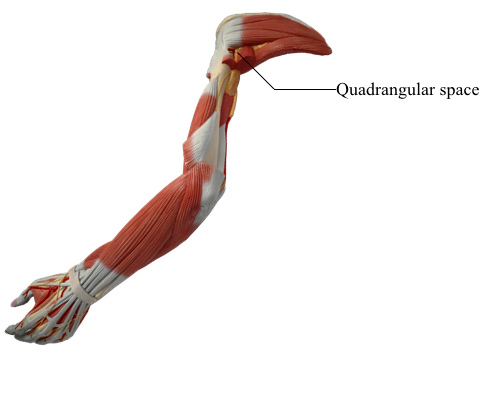Main Model

37 Quadrangular space

Axillary Artery
The axillary artery begins at the lateral border of the 1st rib as the continuation of the subclavian artery, and ends at the inferior border of the teres major. It passes posterior to the pectoralis minor into the arm, and becomes the brachial artery when it passes the inferior border of the teres major, at which point it usually has reached the humerus. For descriptive purposes, the axillary artery is divided into three parts by the pectoralis minor (the part number also indicates the number of its branches):
1. The first part of the axillary artery is located between the lateral border of the 1st rib and the medial border of the pectoralis minor; it is enclosed in the axillary sheath and has one branch - the superior thoracic artery.
2. The second part of the axillary artery lies posterior to pectoralis minor and has two branches - the thoracoacromial and lateral thoracic arteries - which pass medial and lateral to the muscle, respectively.
3. The third part of the axillary artery extends from the lateral border of pectoralis minor to the inferior border of teres major; it has three branches. The subscapular artery is the largest branch of the axillary artery. Opposite the origin of this artery, the anterior circumflex humeral and posterior circumflex humeral arteries arise, sometimes by means of a common trunk.
The branches of the axillary artery are:
• The superior thoracic artery is a small, highly variable vessel that arises just inferior to the subclavius. It commonly runs inferomedially posterior to the axillary vein and supplies the subclavius, muscles in the 1st and 2nd intercostal spaces, superior slips of the serratus anterior, and overlying pectoral muscles. It anastomoses with the intercostal and/or internal thoracic arteries.
• The thoraco-acromial artery, a short wide trunk, pierces the costocoracoid membrane and divides into four branches (acromial, deltoid, pectoral, and clavicular), deep to the clavicular head of the pectoralis major.
• The lateral thoracic artery has a variable origin. It usually arises as the second branch of the second part of the axillary artery and descends along the lateral border of the pectoralis minor, following it onto the thoracic wall; however, it may arise instead from the thoraco-acromial, suprascapular, or subscapular arteries. The lateral thoracic artery supplies the pectoral, serratus anterior, and intercostal muscles, the axillary lymph nodes, and the lateral aspect of the breast.
• The subscapular artery, the branch of the axillary artery with the greatest diameter but shortest length descends along the lateral border of the subscapularis on the posterior axillary wall. It soon terminates by dividing into the circumflex scapular and thoracodorsal arteries.
• The circumflex scapular artery, often the larger terminal branch of the subscapular artery, curves posteriorly around the lateral border of the scapula, passing posteriorly between the subscapularis and the teres major to supply muscles on the dorsum of the scapula. It participates in the anastomoses around the scapula.
• The thoracodorsal artery continues the general course of the subscapular artery to the inferior angle of the scapula and supplies adjacent muscles, principally the latissimus dorsi. It also participates in the arterial anastomoses around the scapula.
• The circumflex humeral arteries encircle the surgical neck of the humerus, anastomosing with each other. The smaller anterior circumflex humeral artery passes laterally, deep to the coracobrachialis and biceps brachii. It gives off an ascending branch that supplies the shoulder. The larger posterior circumflex humeral artery passes medially through the posterior wall of the axilla via the quadrangular space with the axillary nerve to supply the glenohumeral joint and surrounding muscles (e.g., the deltoid, teres major and minor, and long head of the triceps).